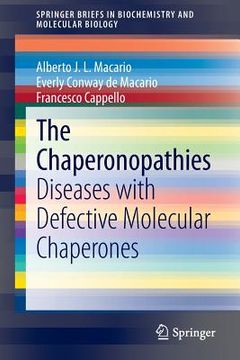Compartir
the chaperonopathies: diseases with defective molecular chaperones (en Inglés)
Francesco Cappello
(Autor)
·
Alberto J. L. Macario
(Autor)
·
Everly Conway De Macario
(Autor)
·
Springer
· Tapa Blanda
the chaperonopathies: diseases with defective molecular chaperones (en Inglés) - Macario, Alberto J. L. ; Conway De Macario, Everly ; Cappello, Francesco
$ 107.667
$ 134.583
Ahorras: $ 26.917
Elige la lista en la que quieres agregar tu producto o crea una nueva lista
✓ Producto agregado correctamente a la lista de deseos.
Ir a Mis Listas
Origen: Estados Unidos
(Costos de importación incluídos en el precio)
Se enviará desde nuestra bodega entre el
Lunes 05 de Agosto y el
Miércoles 14 de Agosto.
Lo recibirás en cualquier lugar de Argentina entre 1 y 3 días hábiles luego del envío.
Reseña del libro "the chaperonopathies: diseases with defective molecular chaperones (en Inglés)"
This Brief provides a concise review of chaperonopathies, i.e., diseases in which molecular chaperones play an etiologic-pathogenic role. Introductory chapters deal with the chaperoning system and chaperoning teams and networks, HSP-chaperone subpopulations, the locations and functions of chaperones, and chaperone genes in humans. Other chapters present the chaperonopathies in general, including their molecular features and mechanistic classification into by defect, excess, or mistake. Subsequent chapters discuss the chaperonopathies in more detail, focusing on their distinctive characteristics: primary or secondary; quantitative and/or qualitative; structural and hereditary or acquired; genetic polymorphisms; gene dysregulation; age-related; associated with cancer, chronic inflammatory conditions, and autoimmune diseases. The interconnections between the chaperoning and the immune systems in cancer development, chronic inflammation, autoimmunity, and ageing are outlined, which leads to a discussion on the future prospects of chaperonotherapy. The latter may consist of chaperone gene and protein replacement/supplementation in cases of deficiency and of gene or protein blocking when the chaperone actively promotes disease. The last chapter presents the extracellular chaperones and details on how the chaperone Hsp60 is secreted into the extracellular space and, thus, appears in the blood of cancer patients with potential to participate in carcinogenesis and chronic inflammation and autoimmunity. Chaperones as clinically useful biomarkers are mentioned when pertinent. Likewise, guidelines for clinical evaluation of chaperonopathies and for their histopathological and molecular identification are provided throughout. The book also provides extensive bibliography organized by chapter and topic with comments.

